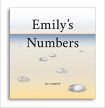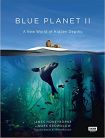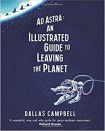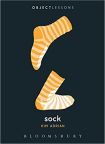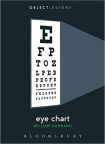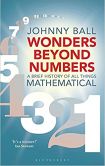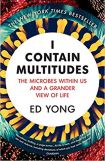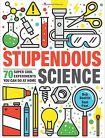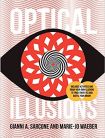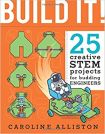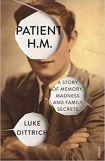|
|
Emily's Numbers by Joss Langford
Emily found words useful, but counting was what she loved best. Obviously you can count anything and there's no limit to how far you can go, but then Emily moved a step further and began counting in twos. She knew all about odd and even numbers. Then she began counting in threes: half of the list were even numbers, but the other half were odd and it was this list of odd numbers which occured when you counted in threes which she called threeven. (Actually, this confused me a little bit at first as they're a subset of the odd numbers but sound as though they ought to be a subset of the even numbers, but it all worked out well when I really thought about it.) of review Full Review |
Blue Planet II by James Honeyborne and Mark Brownlow
You may well remember when the sticking of a number '2' after a film title was suggesting something of prestige - that the first film had been so good it was fully justified to have something more. That has hardly been proven correct, but it has until recently almost been confined to cinema - you barely got a TV series worthy of a numbered sequel, and never in the world of non-fiction. If someone has made a nature series about, say, Alaska (and boy aren't there are a lot of those these days) and wants to make another, why she just makes another - nothing would justify the numeral. But some nature programmes do have the prestige, the energy and the heft to demand follow ups. And after five years in the making, the BBC's Blue Planet series has delivered a second helping. Full Review | |
|
|
Ad Astra: An illustrated guide to leaving the planet by Dallas CampbellSo… you want to leave the planet? Before you do you'd better study the whole history of human space flight to get up to speed. That could take a while… if only there was a handy guide that could condense it all down for you. Enter Dallas Campbell with this book: An illustrated guide to leaving the planet. Full Review |
|
|
Sock (Object Lessons) by Kim AdrianThe subject of this book has been around for several millennia, and yet my partner's daughter has been employed for several years designing it, or them. It's something I use for about 200 days of every year, at a guess (well, I have my self-diagnosed over-active eccrine glands and other people to think about) – which clearly puts me at the opposite end of the scale to well-known mass-murderer of women, Ted Bundy, who was into stealing credit cards to fund his desire of having a fresh pair every single day. On which subject, the amount of them we create every year could stack to the freaking moon and more. Some idiots buy more than six pairs a year, apparently, which is plain stupid. I'm talking, as you can tell, of the humble sock. Full Review |
|
|
Eye Chart (Object Lessons) by William GermanoIt's happened to me, and like as not it has or will happen to you, too. I mean the receipt of certain little numerical results, with a positive or negative before them to prove the correction needed to my vision to make me see with the intended clarity and normality. I've had that gizmo that photos the back of my eye to check for diabetes and other problems, I've had different tests to check the pressure inside my eye, and I've come away with glasses I don't need to wear all the time, but certainly benefit from on holiday, or when watching TV or a cinema or theatre production. And above and beyond that I've stared at – and got wrong – the simple, seemingly ageless test, of various letters in various configurations that diminish in size, to prove to the relevant scientist at what stage things get blurry for me. Of course it's not ageless, but the scientific progress that led to it, the changes other people made to it, and the cultural impact it's had are all on these eye-opening small pages. Full Review |
|
|
Wonders Beyond Numbers: A Brief History of All Things Mathematical by Johnny BallLike many people of a certain age, I have fond memories of tuning in to watch Johnny Ball enthusiastically extolling the virtues of maths and science; succeeding where our schoolteachers had failed and actually making these subjects fun. Although decades have passed since those classic TV shows, his latest book proves that he has lost none of his passion and enthusiasm for his subject. Full Review |
|
|
I Contain Multitudes: the microbes within us and a grander view of life by Ed YongThe world you know is a lie. There is no such thing as good or bad microbes. Sickness and health are all far more complex than we thought. Things designed to save us may kill us and things we think would kill us may save us. Welcome to the modern study of Microbes. Full Review |
|
|
Stupendous Science by Rob Beattie and Sam Peet
Education should be fun. We learn best when we are engaged with practical, enjoyable tasks. That's the secret behind the experiments in Stupendous Science. They have the fun element, the 'wow factor,' and most importantly, can be easily replicated with items that are readily available in the home. Each experiment teaches an important scientific concept; essentially teaching through play. Full Review |
|
|
Optical Illusions by Gianni Sarcone and Marie Jo Waeber
I used to work as a library assistant and I remember arriving to work one morning to find all of my fellow librarians crowded around a book, chattering excitedly and...squinting rather oddly. The book was called Magic Eye and promised a magical 3D viewing experience if you looked at the psychadelic pictures in a certain way. For a brief period in the early 90s, the pictures had a sudden spike in popularity, until everyone presumably got eye strain and went back to their everyday lives. Well good news Magic Eye fans! The pictures are back (albeit only two images), in the engrossing and immersive new book Optical Illusions. Full Review |
|
|
Build It! 25 Creative STEM Projects for Budding Engineers by Caroline AllistonBuild It! 25 Creative STEM Projects for Budding Engineers takes a strictly hands-on approach to science to show how scientific ideas can be applied to real-world situations. The book contains 25 projects with varying degrees of complexity to demonstrate topics such as air travel, programmable machines, light, motion and electricity. The book is designed with the younger scientist in mind, so there is a focus on the fun aspect, with many of the projects involving toys. Full Review
|
The Science of Food: An exploration of what we eat and how we cook by Marty Jopson
I've always believed that if you understood why something worked in a particular way it was very easy to remember how it worked and what you needed to do. The food we eat is no exception to this rule and The One Show resident scientist Marty Jopson has undertaken to explain how things work in the kitchen - and he covers everything from the type of knives we use through to the food of the future. Best of all, he does it in language that even a science illiterate like me can understand. Full review...
The Many Faces of Coincidence by Laurence Browne
Browne does not mislead with this choice of title; he does without a doubt explore the many faces of coincidence. Full review...
Patient H.M.: A Story of Memory, Madness and Family Secrets by Luke Dittrich
Luke Dittrich seeks to shed light on the man behind the initials, and in doing so, uncovers quite a bit more than he expected. Full Review
The Kingdom of Speech by Tom Wolfe
If you are not having a fight with somebody, then you are not sure whether you are alive when you wake up in the morning.
With Tom Wolfe making such bold statements as this even up to the near present (The Guardian in 2004), you can be sure that Wolfe, nearing 87, has lost none of his familiar argumentative style; or that his journalistic days are nearing a close, with his love of melodrama. Full review...
The Smell of Fresh Rain by Barney Shaw
The Smell of Fresh Rain attempts to open our minds to the power and potential of our sense of smell. Barney Shaw, a man armed with only a powerful curiosity and boundless enthusiasm sets out to understand this ever elusive sense and to explore ways to interpret smells in an accessible and simple way. His journey takes him from boatyards to markets via Harrods and his childhood home to uncover the meaning behind everyday scents and to distil the apparently complex nature of smell into language which is accessible and satisfying. Full review...
Neuropolis: A Brain Science Survival Guide by Robert Newman
In Neuropolis, the book and the Radio 4 series, Newman targets a sub-species of pop-neuroscience that he dubs bro-science – a pessimistic, denigrating take on the brain that is based more on macho posing than on research. He sets out to destroy it using proper science. Full review...
Cool Physics by Sarah Hutton
If you aren't entirely sure about a phrase such as Christiaan Huygens states his principle of wavefront sources, don't worry – it was only in 1678 that it happened, so you're not too far behind in physics. Brownian motion, and the gravitational constant being measured both date from before the Victorian era, and all of these three things are on the introductory timeline in this book, which I think might well be proof enough that a primer in the world of physics is very much needed. Full review...
Something or Nothing: A Search for My Personal Theory of Everything by Anthony Marson
Most thinking people have their own theory of the meaning of the universe,and of why they - we - exist within it. It's a natural extension to wonder whether life was created, or, if not created, how was life formed? In Something or Nothing Anthony Marson develops his own theories. The journey began when the author was on a touring holiday in Tasmania, gazed up at a clear night sky and asked himself how and why all the stars came to exist. Although this subject has been explored countless times by scientists, theologians and philosophers, Marson wanted an answer which satisfied him and he begins his search by quite openly admitting that he has only a limited scientific education. It was good to know - for once - that I was on the same footing as the author and we could explore together. Full review...
Admissions: A Life in Brain Surgery by Henry Marsh
Autobiography, Popular Science
It's more than two years since I read Do No Harm: Stories of Life, Death and Brain Surgery but the memories have stayed with me. I had thought then that a book about brain surgery might sound as though I was taking my pleasures too sadly, but the book was superb - and very easy reading and when I heard about Admissions I decided to treat myself to an audio download, particularly as Henry Marsh was narrating. I knew that my expectations were unreasonably high, but how did the book do? Full Review
